Featured Articles Archive
Come to UUSM’s In-Person Annual Meeting - JUNE 5, 2022 AT 12 PM

It’s been another year! We are still in this liminal space and emerging on the other side of the pandemic…moving towards endemic. We are open and we are preparing for our Annual Meeting.
Our IN PERSON Annual Meeting will take place on June 5, 2022, at 12 pm. Members in good standing, please look for your ballot in the mail and in your email inbox. Remember to vote on the resolutions, too.
Votes must be received by Thursday, June 2, at noon.
Please join us in person on June 5! Our existing bylaws require our Annual Meeting to be done in person, and we will not be streaming this year’s Annual Meeting. We would like to entice you to come with a Delectable Vegan Lunch Box provided by the Board of Directors as a thank you to all the wonderful leaders in our community who help us run UUSM by showing up and voting.
Lunch will be served in the Courtyard for members who are prepared to stay and vote. Remember those great coffee drinks? We will have some of those, too.
It will be a time to look ahead with hope for the future and to express gratitude for those who serve our community. Please take a moment and get acquainted with the amazing people who have volunteered to serve on the Board of Directors and Nominating Committee.
Stay tuned for the next exciting post announcing our leadership Folks and our resolutions.
Peace out!
Creatively Yours,
Beth
Beth
Dining for Dollars Wants You… … To Host an Event this Summer
WHAT WOULD YOU LIKE TO OFFER?
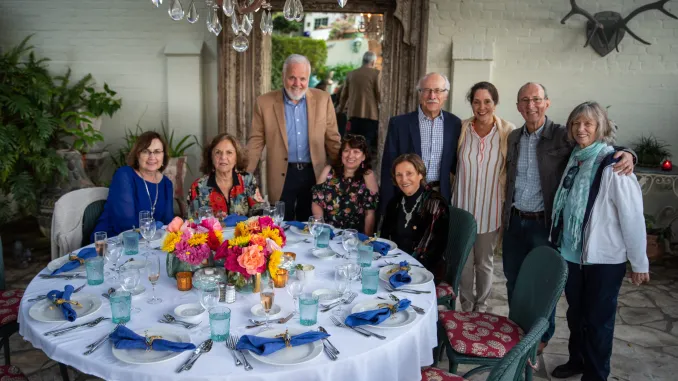
Dear UUSM Community,
Dining for Dollars is this congregation’s fun and community-friendly program that also raises much-needed money. A win-win, for sure!
So put on your thinking cap and please consider hosting an event (or offering goods/service) for members and friends to bid on during our upcoming silent auction, which will be held online at a website called Auctria. Their banner looks like this:

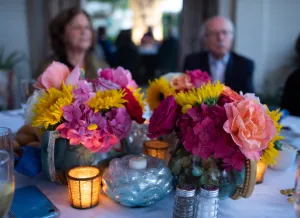 If you would like to offer an EVENT or GOODS/SERVICE for people to bid on, please tell us about it by filling out this form to volunteer. If you prefer not to fill out the online form, you can simply email us at dining4dollars@uusm.org.
If you would like to offer an EVENT or GOODS/SERVICE for people to bid on, please tell us about it by filling out this form to volunteer. If you prefer not to fill out the online form, you can simply email us at dining4dollars@uusm.org.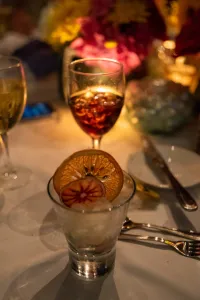 Or visit us at our table in the courtyard on Sundays after the Worship Service. Responses to our survey last month show that people are interested in attending events, most preferring outdoors for the sake of Covid safety. Bidding will begin Sunday, July 3 for events scheduled beginning Friday, July 8.
Or visit us at our table in the courtyard on Sundays after the Worship Service. Responses to our survey last month show that people are interested in attending events, most preferring outdoors for the sake of Covid safety. Bidding will begin Sunday, July 3 for events scheduled beginning Friday, July 8.
Thank you!
The Dining for Dollars Committee,
Karl, Barbara, Farrokh, Resa, Greg, and Pat
Memorial Finale for Pipes Distinguished Lecture Series
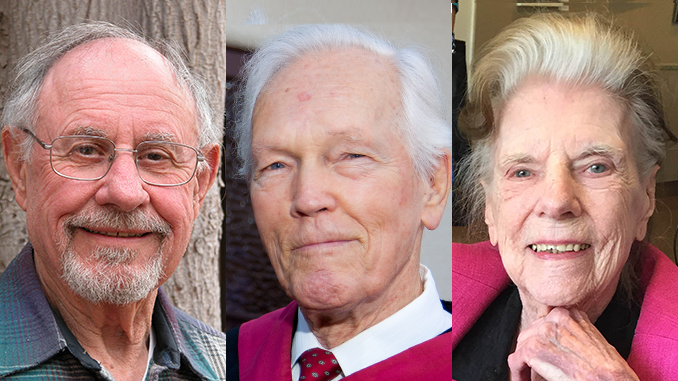
The Pipes Lecture Series will have its Finale on Saturday, May 7 at 5:30 pm in the Sanctuary with memorials to three pillars of the lecture series committee, Leonard Adler, Rev. Ernie Pipes, and Marguerite Spears, pictured above. All three died last year within six months of one another. The committee felt it a fitting time to put on this final event.
Entertainment will be provided by accomplished gospel singer Linda Alvarez; her Mahalia Jackson Tribute Show accompanist, Severn Behnen, who is also Music Director at the UU Palos Verdes church; and William Bryant, Santa Monica College’s Emeritus Gospel Music Choir Director. Bryant’s early career involved working with Motown artists.
We plan to record these events for the church’s record and for those who may not be able to attend. Light refreshments will follow in Forbes Hall.
— Diana Spears and Patrick McGuire
About the Pipes Distinguished Lecture Series
The Pipes Lecture Fund was established in 1991 to honor Rev. Ernest D. Pipes upon his retirement after 35 years in the Santa Monica pulpit. The founding members of the committee (Leonard and Elizabeth Adler, Ray and Betty Goodman, Patrick McGuire, and Marguerite Spears) collected monies for an annual free Pipes Distinguished Lecture Series of renowned guest speakers. The series continued yearly since 1991 with one interruption in 2018. There were no events in 2020 or 2021.
The series began with William Schultz, President of the Unitarian Universalist Association, and has included luminaries such as Ramona Ripston, Patt Morrison, Arianna Huffington, Michael Dukakis, George Takei, Father Gregory Boyle, and Reza Aslan. It resumed in 2019 with an organ recital — something Ernie had always desired because our organ was handpicked in Italy by the Goodmans to complement the acoustics of our Sanctuary. The committee was also able to provide money to repair our ailing organ.
Previous Speakers in the Ernest D. Pipes Distinguished Lecture Series
1st - 1991 - William Schulz, President of the Unitarian Universalist Association - “Religion in The 21st Century”
2nd - 1993 - Deborah Prothrow-Stith, MD, Expert on Community Violence - “Adolescent Violence and Its Impact On The Community”
3rd - 1994 - Rev. Peter Kreitler, Episcopal Minister, Historian/Educator - “The Environment and the Church”
4th - 1995 - Ramona Ripston, Executive Director of the ACLU Foundation of Southern California - “Equal Justice Under The Law”
5th - 1996 - Patt Morrison, LA Times and KCET Journalist and Commentator - “Bumper Sticker Politics and Hair Spray News”
6th - 1997 - Rep. Anthony Beilinson, Former Member of US Congress - “Politics: Past and Future Perspectives”
7th - 1998 John B. Anderson, Former Member of US Congress; 1980 Candidate for US President - “Why a Livable World Requires a Restructured and Empowered United Nations”
8th - 1999 - Kennard Lipman, PhD, University of Judaism - “The Dancing Cosmos: What I Learned About God from Buddhism”
9th - 2000 - Robert Sheer, LA Times Journalist and Commentator - “Sex, Politics, and Sheer in the 21st Century”
10th - 2001 - Margo Reeg, League of Women Voters of California - “Make Every Vote Count”
11th - 2002 - Charles Haskell, MD, Chief Ethics Officer, US Department of Veterans Affairs - “Health Care Ethics”
12th - 2003 - Arianna Huffington, Chief Editor of Huffington Post - “How Corporate Greed and Political Corruption are Undermining America”
13th - 2004 - Erwin Chemerinsky, USC School of Law - “Civil Liberties and the War on Terrorism”
14th - 2005 - Tom Plate, UCLA School of Public Policy - “America and China, Odd Couple or Fatal Attraction?”
15th - 2006 - Michael Dukakis, Former Governor of Massachusetts; 1988 candidate for US President - “The Health Care Crisis, 45 Million and Counting”
16th - 2007 - Dr. Gary Small, UCLA Center on Aging - “Strategies for Living Better Longer”
17th - 2008 - Mike Farrell, Actor/Activist - “Where Do We Go From Here?”
18th - 2009 - Tim Rutten, LA Times Journalist and Commentator - “Does News Have a Future?”
19th - 2010 - George Takei, Actor/Activist - “Embracing Change”
20th - 2011 - Father Gregory Boyle, Executive Director of Homeboy Industries and Anti-Gang Activist - “The Power of Boundless Compassion”
21st - 2012 - Reza Aslan, PhD in Religions, Author or No god but God, and founder of AsianMedia.com - “Islam in the 21st Century”
22nd - 2013 - Steven D. Goodman, PhD, California Institute of Integral Studies, San Francisco - “Opening the Heart of Compassion: Buddhist Reflections”
23nd - 2014 - Sandy Banks, LA Times Journalist and Commentator - “Foster Care: Behind the Headlines – The Pain and Promise of Broken Families”
24th - 2015 - James Dusenberry from Al Gore’s Climate Reality Project - “Climate Change! Global Warming! CO2 Emissions!”
25th - 2016 - Rev. Dr. William Schulz, Executive Director of Amnesty International USA, President and CEO of the UU Service Committee - “Seeing the Garden, Not Just the Wall”
26th - 2017 - Rev. Judith Meyer, UUSM Minister Emerita - “Falling Out: Alienation and Community in Divisive Times.”
27th - 2019 - Organist Jeffrey Parola - Organ Recital
On the Banks of the Dnieper
A PERSONAL CONNECTION TO THE WAR IN UKRAINE
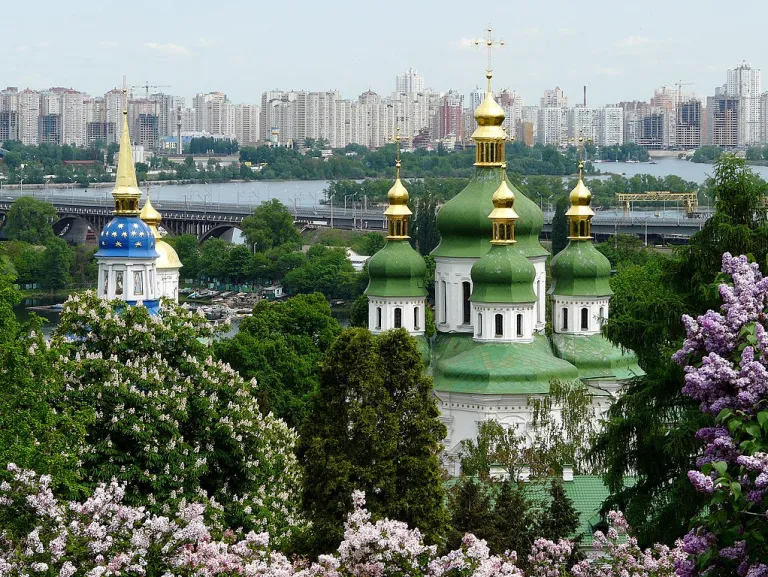 Vydubychi Monastery: Saint George Cathedral (1696-1701) and bell tower (1727-1733), Kyiv, Ukraine. You can see the Dnieper River, with the apartment complexes in the background. Kyiv is home to 2.8 million people. Photo by Nick Grapsy. Wikimedia Commons finalist for Picture of the Year 2015. Licensed under the Creative Commons Attribution-Share Alike 4.0 International license.
Vydubychi Monastery: Saint George Cathedral (1696-1701) and bell tower (1727-1733), Kyiv, Ukraine. You can see the Dnieper River, with the apartment complexes in the background. Kyiv is home to 2.8 million people. Photo by Nick Grapsy. Wikimedia Commons finalist for Picture of the Year 2015. Licensed under the Creative Commons Attribution-Share Alike 4.0 International license.
Written by Sarah Robson
To support our Generous Congregations Contribution this month to the International Rescue Committee, along with our UUA theme of Renewing Faith, I feel compelled to tell a personal story about my connection to Ukraine that I hope will inspire.
At 10 years old, in 1980, I knew what I wanted to be in life – a diplomat for peace between the Soviet Union and America. With 40,000 Russian and 20,000 American nuclear warheads either ready to launch or stockpiled in the 80s, diplomacy was critical. I started learning Russian at age 12, when I found a browned copy of “Russian Made Easy” printed in the 60s. The Cyrillic was fun to learn, but unlike the promise of the title, the grammar was overwhelming. Still, I persisted.
In 1990, I got my chance to stay with a family in Cherkassy, in Soviet Ukraine. The father, Pyotr Evtushenko, was the governor of the Cherkassy Oblast (an oblast is similar to but bigger than a typical US county). He was a very proud communist and Soviet citizen. He was happily married to Tamara (Toma), who worked in a ceramics factory. She was an extraordinary cook.
Lesya, their 20-year-old daughter, wanted to become an English teacher, so she was excited to host me. She was proud of her native language, Ukrainian, and taught me a few words. One old Ukrainian word she taught me was “Bachanyutka” – you would shout it out to alert someone if they were about to step into something unmentionable. A cute word, I thought.
The family had a little dacha, which is a tiny summer house, in the countryside. We visited it to get fresh produce, and in this case – I picked gooseberries. The weather was lovely, and it was a joy to be in the large garden. I saw peculiar insects and heard the chirps and calls of birds I had never heard before. I realized during my time there how strong the community was. Food supplies were unpredictable, so people stocked up and then spread the food around. Because of the sharing, there were many friendly gatherings.
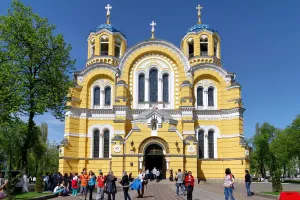 Despite the thaw of the Cold War, the KGB was still strongly interested in the activities of Americans within Soviet borders, and we were always followed by a man about 20 feet behind us. One time, I turned around and acknowledged the officer, but Lesya in a panic took me and said, “No! Do not look!” I could sense a great deal of fear in her voice.
Despite the thaw of the Cold War, the KGB was still strongly interested in the activities of Americans within Soviet borders, and we were always followed by a man about 20 feet behind us. One time, I turned around and acknowledged the officer, but Lesya in a panic took me and said, “No! Do not look!” I could sense a great deal of fear in her voice.
It was in Kyiv at Saint Volodymyr’s Cathedral in the city center that I was introduced to a vastly different and intriguing form of Christianity than what I had been exposed to in the West. It planted a seed of curiosity for Eastern Orthodoxy, which has colored my spiritual life ever since.
 On that trip to Kyiv, I saw firemen hosing down buildings that weren’t on fire. I asked, what are they doing? Lesya stated, “Kyiv is 100 kilometers (60 miles) south of Chernobyl, so they must wash radiation from the buildings.” I looked at the puddles collecting on the streets ahead of us. I pointed, “Bachanyutka?” Lesya nodded sagely, and said, “Yes, we should go around.”
On that trip to Kyiv, I saw firemen hosing down buildings that weren’t on fire. I asked, what are they doing? Lesya stated, “Kyiv is 100 kilometers (60 miles) south of Chernobyl, so they must wash radiation from the buildings.” I looked at the puddles collecting on the streets ahead of us. I pointed, “Bachanyutka?” Lesya nodded sagely, and said, “Yes, we should go around.”
Lesya eventually got married to a man named Alexander, and they had a son, Losha. I admit, I hadn’t spoken to her in 30 years, but my dad stayed in touch and kept some dialogue through Facebook. This past week, I spoke with her through Facebook video calls. We were both in tears. The family cannot believe this war is happening. Putin has clearly lost his mind, speaking like a man having a true psychotic breakdown.
Cherkassy, also on the Dnieper River, is 100 miles south of Kyiv. It is not yet under bombardment. I quote Lesya, “Never in my life had I imagined I would hear air strike warning sirens.” Since it’s just down the river, we all worry it will be on the immediate list of targets if Kyiv is taken. My father has already offered to wire her money if they become desperate, and a gracious family in Santa Rosa is willing to take in the entire family if they can make it to LAX – I will personally escort the family to Santa Rosa if they arrive. With 2 million women and children already flooding the borders, it might be very tough to make it through.
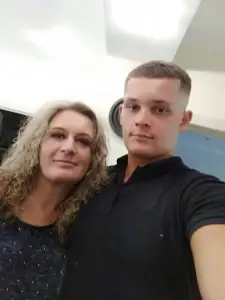 I will keep people updated on Lesya Degtiariova, her 75-year-old mother Toma, Lesya’s husband Alexander, and her 20-year-old son Losha. Both men have been conscripted into the Ukrainian army reserves and will probably fight trained Russian soldiers in urban combat. (Her father Pyotr died a few years ago). I will follow them as much as I can – as long as Facebook still functions, thanks to SpaceX’s Starlink.
I will keep people updated on Lesya Degtiariova, her 75-year-old mother Toma, Lesya’s husband Alexander, and her 20-year-old son Losha. Both men have been conscripted into the Ukrainian army reserves and will probably fight trained Russian soldiers in urban combat. (Her father Pyotr died a few years ago). I will follow them as much as I can – as long as Facebook still functions, thanks to SpaceX’s Starlink.
Lesya says that after the war she wants to visit us in Los Angeles with her son Losha. They will be here either as refugees or as tourists. Either way, if they survive the onslaught, I hope you meet them.
Maybe I could return to the sovereign nation of Ukraine to help rebuild Kyiv. I am even learning Ukrainian, which is similar to Russian. This is something to dream about and look forward to in a remarkably dark and treacherous time.
Even if the walls all cave in and there is nothing but dust, rubble, smashed glass, and tangled rebar; even if all the beautiful churches fall, their golden cupolas melted onto the streets, the ancient icons torn apart by tank treads; even if the once proud statues of historical and emblematic figures become headless and armless – sometimes all one needs is faith in a positive future. I do believe one day, “all shall be well,” as Julian of Norwich said. And we are most well when we stand together in camaraderie as one human family.
 International Rescue CommitteeLearn more about IRC and our Generous Congregational Contribution HERE. To make a contribution, please visit archive.uusm.org/make-a-donation, opting for GCC.
International Rescue CommitteeLearn more about IRC and our Generous Congregational Contribution HERE. To make a contribution, please visit archive.uusm.org/make-a-donation, opting for GCC.
To learn more about the International Rescue Committee, visit www.rescue.org.
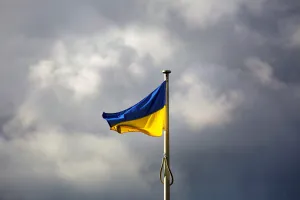
How to Contribute to the $10,000 Spirit Level Foundation Worship Assistance Matching Grant - A HELPFUL STEP-BY-STEP TUTORIAL
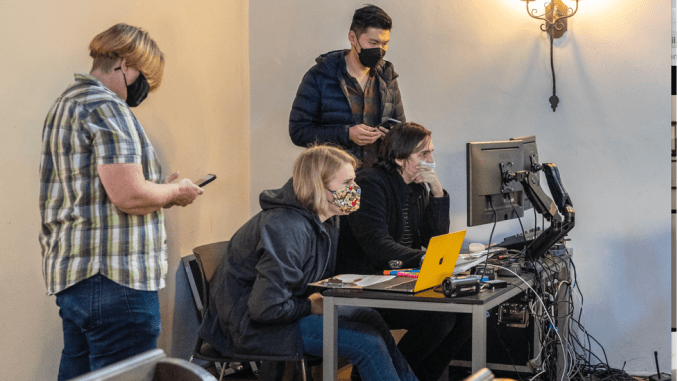
Churches are volunteer organizations. We survive because of our members, who invest time and money to support something in which we all believe. For our own UUSM Sanctuary at Eighteenth and Arizona, the Spirit Level Foundation Worship Assistance Matching Grant offers us the opportunity to match up to $10,000, yielding UUSM a total of up to $20,000. Even though we are only slowly getting back to worshiping in our sanctuary on Sunday mornings, we can still “be there” because of the technology that we have invested in to livestream worship services through Facebook and YouTube. By late January of 2022, we had already logged $5,000 in contributions. Want to max out the matching donation and double your donation? Here’s how.

Note: If you are using this guide to complete your online contribution to this Matching Grant, you will have an easier time keeping this tab open in your browser and opening a separate tab to log into the website. Alternatively, print out this PDF file and have it handy as access the website normally.

Here’s how to contribute from the UUSM church webpage
1) Go to UUSM.org
At the top right corner of the home page, click on the words MAKE A DONATION (see red arrow below).
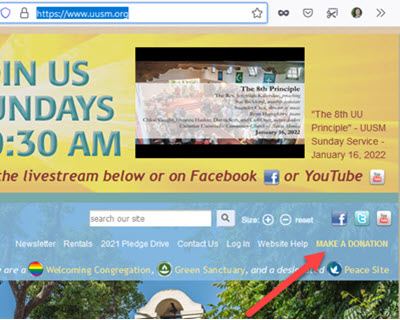

2) Once you are on the Make a Donation page, click the blue strip “UUSM ONLINE: Make a donation now” (see red arrow below).
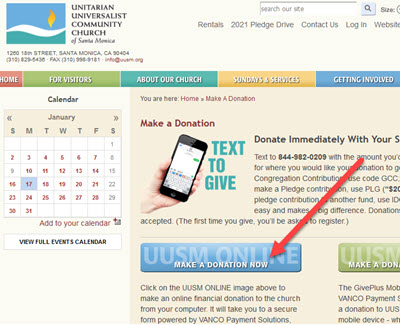

3) This will bring you to the Donation page.
Look to the top right of the web page for the Vanco Login area. Using your Vanco login is quite handy because you can set up your donation method for this and future contributions. Here, you can log in using your existing Vanco account or you can create a new one. For the sake of this tutorial, I’ll log in using my Vanco account (see red arrow below).


4) After you have logged in, click on the Add Transaction button (see red arrow).
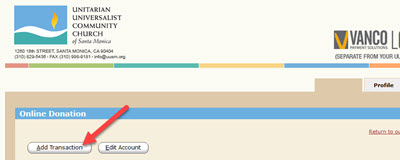

5) This will bring you to the Online Donation/ Donations page, then scroll down to the Program Support area of the page (see red arrow below).
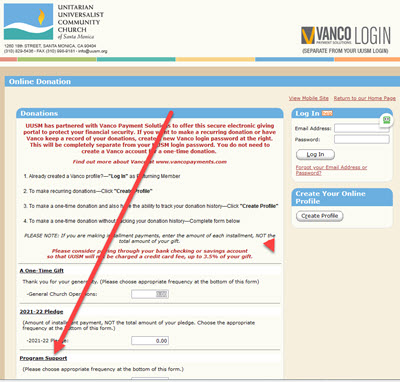

6) Under the Program Support heading, you see many options, including OTHER.
To the right of the “OTHER” line, you see a blank field for you to designate this specific area of support. Click in that blank field and type “Worship Assistance Matching Grant” (see red arrow below).
To the left of that, type in the amount you want to contribute (see green arrow below). I typed in $1 so that this tutorial would populate correctly. Obviously, your contribution would exceed this amount.
After you have completed these two tasks, look down to the Donation Frequency “Choose One” button (see yellow arrow below). Click on that.
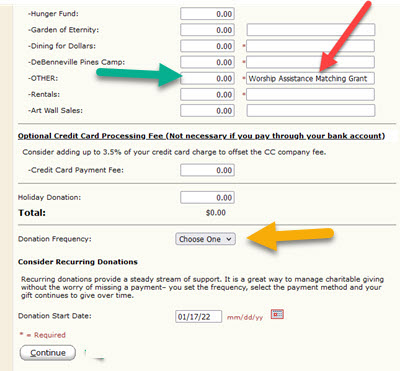

7) To the right of “Donation Frequency,” click on the “Choose One” choice button. You’ll see your automatic frequency choices for your donation.
In this documentation, I’m choosing One Time (see red arrow below). After you’ve made your choice, click on the Continue button (see green arrow below).
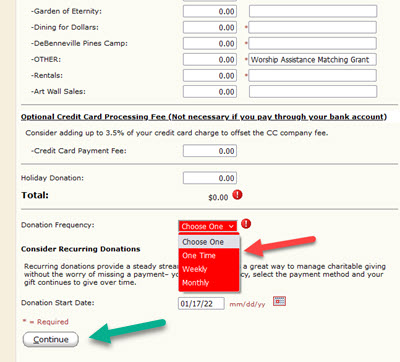

8) On the Online Donation / Donation Information page, choose which account source you wish to use for the source of your donation (see red arrow below).
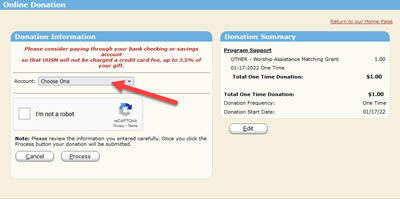

9) From the choices for your donation source that you have already given Vanco, make your choice. In this demonstration, I will choose my checking account as the source for the donation (see red arrow below).
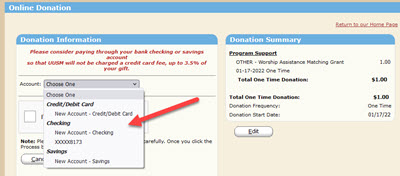

10) Once you’ve made your choice for the source of your donation, click on the “I am not a robot” check box (see red arrow below).
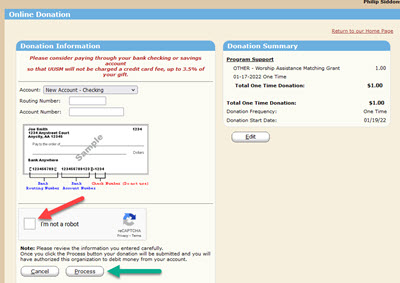

11) You will be forced to play the image game to prove you are not a robot. Once you’ve correctly chosen the images, click Verify.
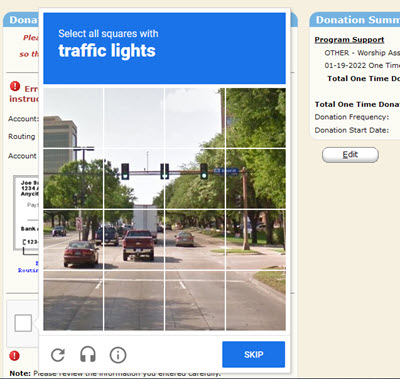

12) Lastly, click on the Process button (see green arrow in step 10 above). This will complete your contribution through Vanco.

You will finally be presented with a receipt for your donation.
As you can see at the bottom of the receipt, you can print your receipt and return to the UUSM.org home page. Thank you for your donation.
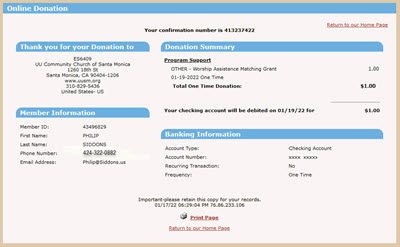
You can use this same process to make donations and payments to other funds at UUSM.org.
Who are the Tongva and Why Do We Acknowledge Them in Our UUSM Services?
RECOGNIZING THE ORIGINAL STEWARDS OF THE LAND WE ARE OCCUPYING
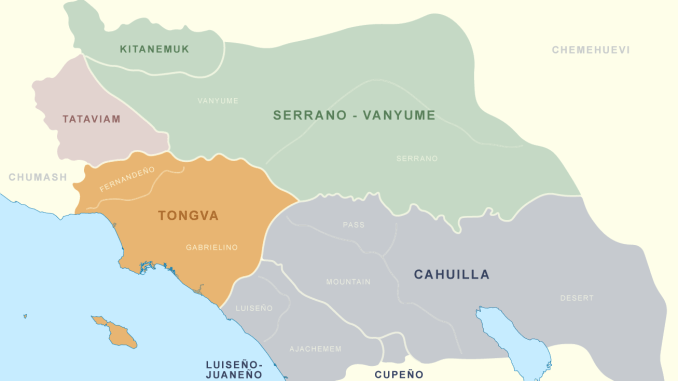
Takic language map by Noahedits, CC BY-SA 4.0, via Wikimedia Commons
“Our church and the homes of most of our members are on the traditional, ancestral and unceded lands of the Tongva people, who continue to live here and who cared for these lands for thousands of years. We recognize and mourn the often-deadly harm inflicted on the indigenous people of this country. We lift up their grace, resilience, and their relationship with these sacred lands.”
We hear these words during every UUSM service now, and while the message is clear, it has often piqued our curiosity and made us (especially those of us who didn’t grow up in Los Angeles and didn’t study California history in fourth grade) want to learn more about the Tongva people: Who are they? What is their history? Where are they today? And why have UUSM and many other organizations (including some municipal governments) started using these kinds of public “land acknowledgements” in public gatherings?
Here are a few answers, and some resources for further information.
Who are the Tongva and what is their history?
The Tongva are an indigenous people from the Los Angeles basin and Southern Channel Islands. According to Wikipedia, the Tongva had as many as 100 villages in a 4,000 square mile area and “primarily identified by their village name rather than by a pan-tribal name.”
Radio station KCRW adds that “Tongva villages were often built near rivers, creeks, and other sources of water. Their biggest village was called Yangna and it sat right where downtown LA sits today, near the Los Angeles River. The Tongva traded extensively between themselves and with other tribes- like the Chumash, their neighbors to the North and West.”
And the LAist website notes that “If you live in what’s now known as the Los Angeles Basin, you’re living on what its Indigenous residents call Tovaangar, which means “the world.”
“Along with the neighboring Chumash,” Wikipedia says, “the Tongva were the most influential people at the time of European arrival. They developed an extensive trade network through te’aats (plank-built boats) and a vibrant food and material culture based on an Indigenous worldview that positioned humans, not as the apex of creation, but as one strand in a web of life (as made evident in their creation stories). Over time, different communities came to speak distinct dialects of the Tongva language, part of the Takic subgroup of the Uto-Aztecan language family. There may have been five or more such languages (three on the southernmost Channel Islands and at least two on the mainland).”
In the 1700s, however, after the founding of the Mission San Gabriel, many Tongva were enslaved, forcibly relocated and/or victimized by treaties that promised but never delivered land and other benefits. The Tongva are also called “Gabrieleño” and “Fernandeño” after the missions built on their land.
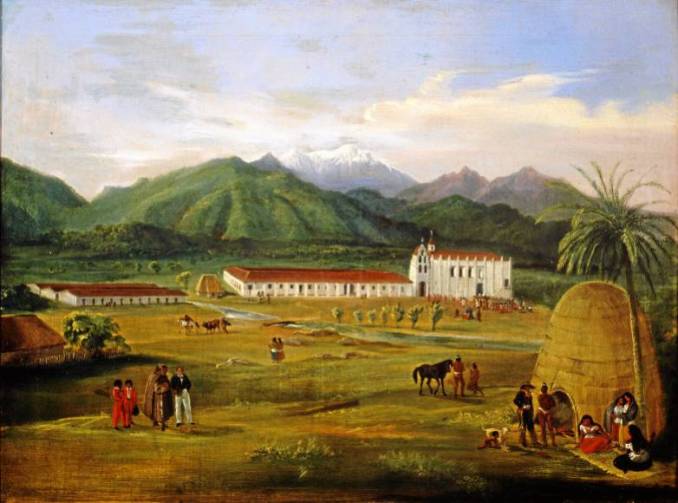
Painting of Mission San Gabriel by Ferdinand Deppe (1832) showing a Gabrieleño kiiy thatched with tule.
Where are the Tongva now?
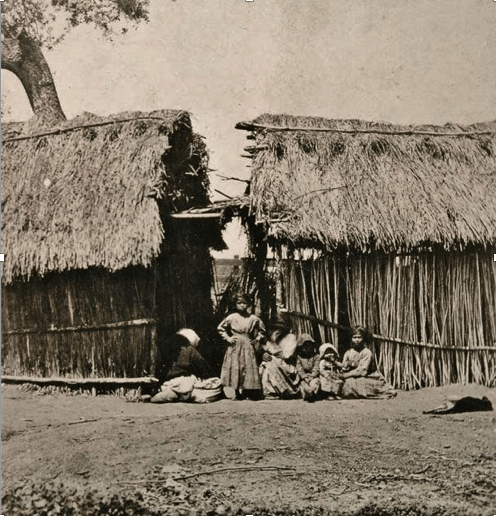
According to Wikipedia, the Tongva were rumored to have died out by the early 20th century, but in reality, “a close-knit community of the people remained in contact with one another between Tejon Pass and San Gabriel township.”
Since 2006, Wikipedia continues, four organizations have claimed to represent the people: the Gabrielino-Tongva Tribe (the “hyphen” group), the Gabrielino/Tongva Tribe (the “slash” group), the Kizh Nation (Gabrieleño Band of Mission Indians), and the Gabrieleño/Tongva Tribal Council.
But while the state of California now officially recognizes the Gabrielino as “the aboriginal tribe of the Los Angeles Basin,” the federal government does not recognize any organized group representing the Tongva – even though by 2008, “more than 1,700 people identified as Tongva or claimed partial ancestry,” and “in 2013, it was reported that the four Tongva groups that have applied for federal recognition had over 3,900 members collectively.”
Today, reports KCRW, “Roughly two thousand Tongva descendants live in Los Angeles,” and many communities in the foothills of the San Gabriel mountains, including Rancho Cucamonga, Azusa, Pacoima, Tujunga have names that originated with the Tongva. The last of these – “Tujunga” – “comes from the word ‘tohu’ which is like an elder woman or an esteemed elderly woman in the community.”)
What are “Land Acknowledgements” and why are UUSM and other organizations doing them now?
In a 2019 statement about the practice, California State University Long Beach says, “Simply stated, a land and territorial acknowledgment is a statement that recognizes the ongoing presence and relationship of the First Peoples whose land an institution occupies. For First Peoples, this recognition is protocol for visitors and guests travelling, working, or living in a community that is not their original homeland. The statement expresses an awareness about the dispossession of the indigenous peoples of the land to make visible ongoing forms of settler-colonial privilege and dominance.”
And according to the LAist story mentioned above, the statements have more recently become “more visible in the U.S. in the last several years as public officials, universities, nonprofits and others start to incorporate land acknowledgment into their regular communications.” Land acknowledgements are “an important step in the process of “rematriation” — the reunion of the land with its original caretakers and stewards.”
“By stating our name, by talking about us, by making ‘Gabrielino Tongva’ a word that people know, it makes them consciously think about the land that they’re occupying and standing on, and that they’re guests of this land,” said Kimberly Morales Johnson, tribal secretary for the San Gabriel Band of Mission Indians/Gabrielino Tongva and a member of the Los Angeles City/County Native American Indian Commission, in the LAist story.
Where can we learn more about the Tongva?
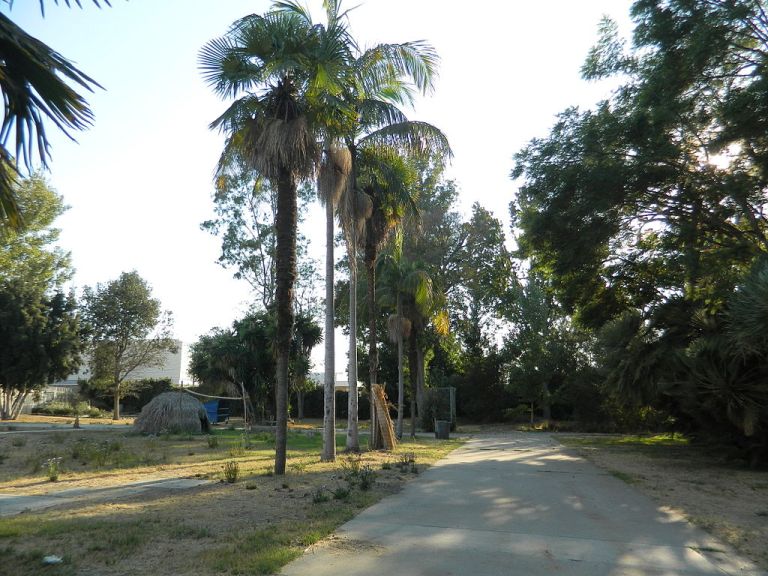
Kuruvungna Springs photo by Jengod via Wikipedia.
For more information virtually, see the three stories linked to above, or any of the other links in the Further Resources section below. But if you’d like a more real-world experience, you might also consider visiting a Tongvan sacred creek, Kuruvungna ( “a place where we are in the sun”) Springs, located very close to Santa Monica on the campus of University High School at 1439 S. Barrington Ave.
The site is leased from LAUSD and maintained by the non-profit Gabrielino/Tongva Springs Foundation, and it contains not only the well-preserved natural resource, but also the Kuruvungna Village Springs & Cultural Center, featuring “artifacts, historical documents, photo collections and other historical resources directly associated with the history of the Tongva people as well as the High School.”
According to the Foundation website, the area is open to the public the first Saturday of each month from 10 a.m. to 3 p.m. And if you’d like to learn more about the springs before you visit, see the Foundation link above, or this recent story from Alta Online.
Resources for Further Reading:
Happy 100th Birthday to Helen Brown
by Katy Malich
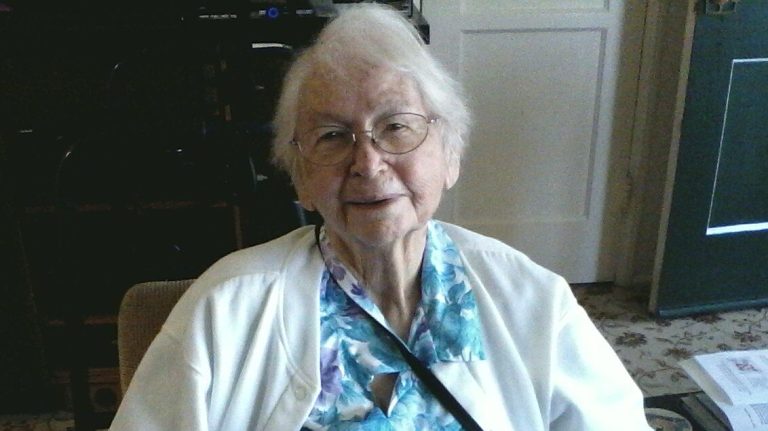
Ten years ago, longtime UUSM member Helen Brown celebrated her December 10 birthday by taking a flying lesson.
Lots of people take flying lessons. But I don’t know anyone else who did it on their 90th birthday.
Helen’s flight was significant in more ways than one. When the Japanese attacked Pearl Harbor 80 years ago, Helen was just hours away from having enough flying time to qualify for her pilot’s license. The attack put an end to civilian aviation and Helen’s dreams of flight. But she did her part to support the war effort. And after the war ended she lived on a military base in Germany with her GI husband, Grant, working on postwar German reconstruction.
Helen and Grant moved back to California upon return to civilian life. Their daughter had special needs. Helen was her staunch supporter and advocate throughout school, scouts, and adulthood. In fact, Helen went back to school and became a speech pathologist to help other children like her beloved daughter.
Helen’s caretaking skills were called upon again when her husband was diagnosed with Parkinsons. Helen was active in local Parkinson support groups and our church’s caretaker support group, providing valuable advice and assistance to one and all.
Prior to COVID, Helen participated in a number of other church groups and activities, including Dining for Dollars, the Women’s Alliance Sewing group, the Green Committee, the Super Seniors Group, and Bruno Lacombe’s weekly exercise classes. She prefers mystery novels and public television to the internet, but thanks to church member Greg Wood she’s been able to listen to our weekly online services during the closure of our physical building.
Helen was an avid-cruise goer, classical music fan, and a proud alumma of Hollywood High School. She loved gardening and was an early convert to xeriscaping, replacing her front yard with a drought tolerant garden of California native plants which she designed herself. I was so excited about her front yard that I’d inadvertently embarrass Helen whenever telling others about how fantastic it was. (Spoiler: It is. It really is.)
Knowing Helen’s reticence and desire to keep a low profile, I called Helen to tell her I’d been asked to write a little something for the newsletter for her 100th birthday. I asked her if she’d ever forgive me for writing this. It could have been the phone connection, but I’m not sure I ever got an audible response. Knowing Helen, she’d probably rather not have a fuss made over her. I’m sorry Helen. You mean so much to so many of us we want to acknowledge your special day.
There will be a little in-person, socially distanced fuss, too. I’m pretty sure the members of her longtime knitting group will celebrate her 100th at their weekly COVID-safe outdoor gathering in Cloverfield Park.
If you want to wish Helen a happy birthday, her home address is in the directory. Yes, at 100 years old, she’s still in her own home with her beloved cat, Butterscotch. Happy birthday, Helen.
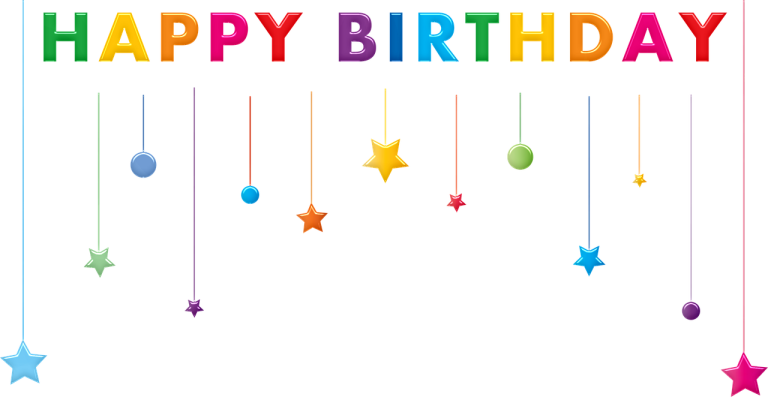
Fans and Friends of Camp de Benneville Pines: Opportunity Alert!!
SHARE YOUR LOVE!
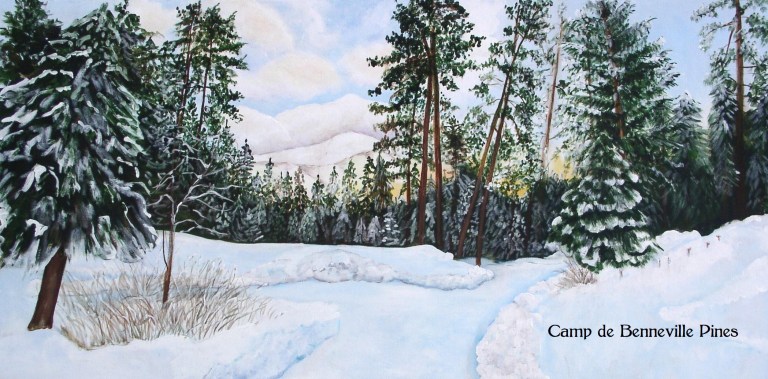
By Rick Teplitz
Pam and I already had plans to include Camp de Benneville Pines in our holiday end of the year charitable donations. When we heard about the DOUBLE MATCH available, we got right on it.
UUSM is participating in a mini-match to raise funds for the camp, which means that any donation sent between now and December 31, 2021 will be matched dollar for dollar. For example, $25 becomes $50, $50 becomes $100, etc. Any and all amounts are welcome!
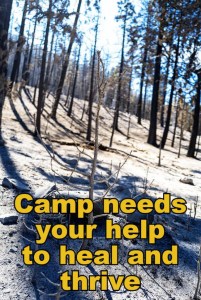 But it doesn’t stop there! Other friends of the camp have set up another special matching fund for the same time period, the “Share Your Love Matching Gift Campaign,” with the goal of encouraging Southwestern UUs to contribute. This fund will again double the gift, as noted above, dollar for dollar.
But it doesn’t stop there! Other friends of the camp have set up another special matching fund for the same time period, the “Share Your Love Matching Gift Campaign,” with the goal of encouraging Southwestern UUs to contribute. This fund will again double the gift, as noted above, dollar for dollar.
Here’s the special sauce: if you designate your donation for Camp de Benneville Pines by December 31, 2021, noting UUSM as your participating congregation, it will be matched by UUSM and that doubled amount will be matched again by the Share Your Love match!! Your $25 contribution is matched two times and becomes $100, while a donation of $100 becomes $400!
All donations are gratefully received and go to support our camp at a time of great need. During the two years of the COVID crisis and forest fires, camp rentals and activities were essentially shut down and the camp requires our additional support.
Those who are able can contribute online at https://www.uucamp.org/contribute/share-your-love/. Please be sure to scroll to the bottom of the form on that page and indicate UUSM in the affiliation drop down menu and “de Benneville match” in the comments.
You can also write an send a check to UUSM with “de Benneville match” in the memo line, or donate online at https://uusm.org/donate, entering the amount you want to donate into the Camp de Benneville Pines fund and noting “de Benneville match” in the memo line. The office will have to subtract any credit card fees however, and then write a check to send to Camp de Benneville to be matched. The office recommends that the most timely and cost effective way to donate is to go directly to the Camp de Benneville Pines website and contribute there, or write a check directly to Camp de Benneville Pines, 41750 Jenks Lake Road West, Angelus Oaks, CA 92305-9789, and write “UUSM Matching Donation” in the memo line.
However you donate, thanks for caring about our UU home in the mountains!
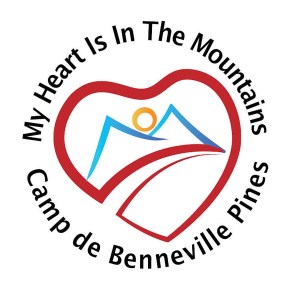
Towering Succulents in our Church Courtyard
BEAUTIFUL AND DROUGHT-TOLERANT LANDSCAPE DESIGN
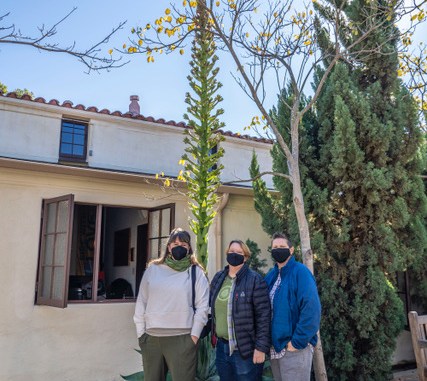
The lovely tall succulents around our campus are Blue Flame Agaves. Many were planted in 2008 when we landscaped the courtyard, though they have been thinned out as they grew. The impressive flower spikes can grow to 22 feet high. The Blue Flame Agave plant is very drought-tolerant and long-lived, and a favorite for landscape use in our area.
Our landscape design was prepared in 2007 as a donation to the church by member and Landscape Architect Keith Ludowitz. The design features many drought-tolerant plants like the Blue Flame Agave, Agave shawii x attentuata. This plant’s flamelike leaves, along with planters in front of the cottage that resemble stone chalices, bring to mind the flaming chalice symbol of our religion.
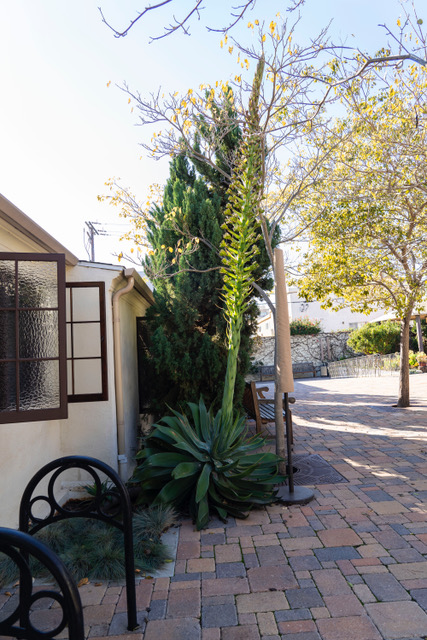 The entire courtyard is paved in permeable pavers which allow rainwater to percolate down into a reservoir beneath the courtyard and eventually back into the groundwater so that the stormwater system is not overwhelmed, which would result in pollutants being swept into the ocean. We received a grant from the City of Santa Monica to incorporate these green features, which helped offset the extra cost. The reservoir is sized to offset a Religious Education building which the City approved to be built where the parking area and shade structure are now. However, during the 2008 recession, the Board decided not to proceed. Instead, Forbes Hall was remodeled.
The entire courtyard is paved in permeable pavers which allow rainwater to percolate down into a reservoir beneath the courtyard and eventually back into the groundwater so that the stormwater system is not overwhelmed, which would result in pollutants being swept into the ocean. We received a grant from the City of Santa Monica to incorporate these green features, which helped offset the extra cost. The reservoir is sized to offset a Religious Education building which the City approved to be built where the parking area and shade structure are now. However, during the 2008 recession, the Board decided not to proceed. Instead, Forbes Hall was remodeled.
Blue Flame Agave
Agave shawii x attenuata ‘Blue Flame' is a highly sought after succulent that works well in any landscape setting. These soft-edged agaves grow in a clumping pattern with tight rosettes of blue foliage that appears almost flamelike in its growth habits. These agaves are not only a great drought tolerant water-wise choice but they are also considered to be fire-wise. Slower growing than most agave species, these are long-lived agaves that add color and beauty even when planted in pots.
Growing in their native Mexico, these plants are well adapted to many different soil and weather conditions and this makes them great to be planted in any Southern California landscape.
The next time you are in the church courtyard, take a moment to enjoy our majestic Blue Flame Agave and other carefully chosen plants and features.
UUSM Sunday Morning Worship Online and In-Person
HOW IN-PERSON SERVICES WORK
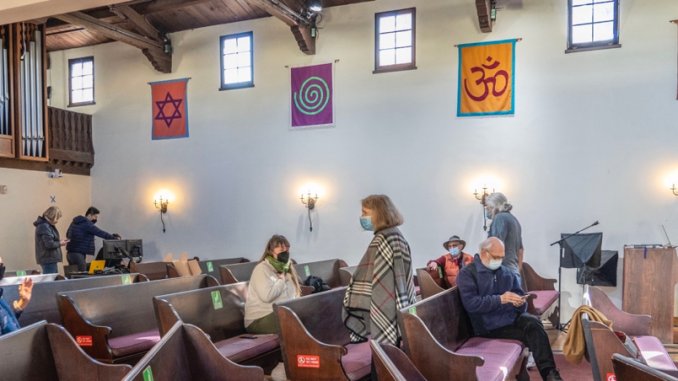
Worship Service in the UUSM Sanctuary on December 12, 2021.
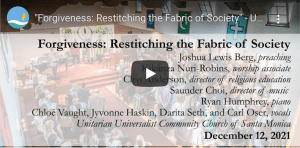 Most people see this opening screen as they tune into the UUSM Sunday Worship Service remotely. For the immediate future, most people will continue to experience Sunday Morning Worship this way.
Most people see this opening screen as they tune into the UUSM Sunday Worship Service remotely. For the immediate future, most people will continue to experience Sunday Morning Worship this way.
But since September, our sanctuary has been lightly populated on Sunday mornings. Let’s see how they do it.
The Tech Team coordinates the event, signaling to the pulpit and the musicians when to speak, sing, and play, all the while showing on screen to viewers at home the transitions that mark the different parts of the worship service (like “Covenant” and “Hymn of Praise”).
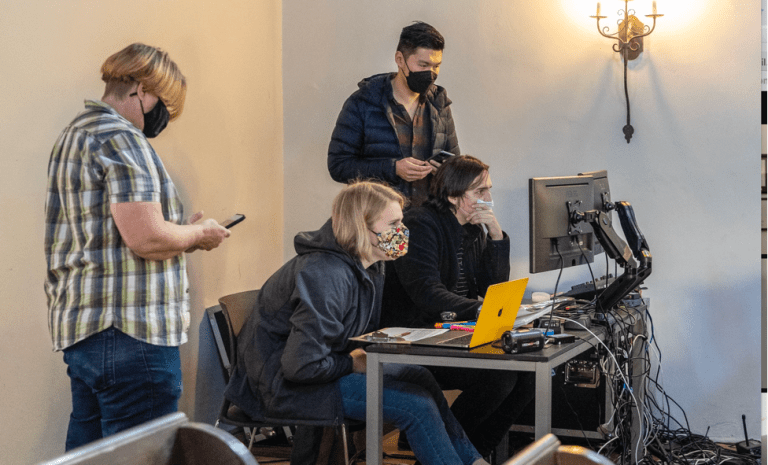
Aubrey and Adran seated at the tech board. Cassie and Saunder looking on.
On the chancel, the day’s Worship Associate and Minister conduct worship in mostly the traditional way, but mindful of the fact that there is an in-person audience as well as a much larger audience (mediated by a camera) that they are addressing.
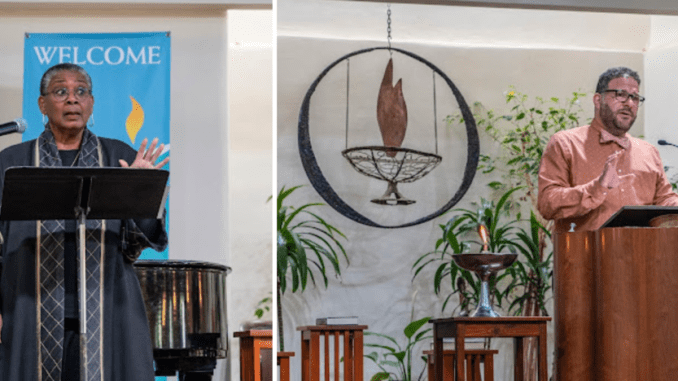
Worship associate Kikanza Nuri-Robins and guest minister Joshua Lewis Berg, preaching.
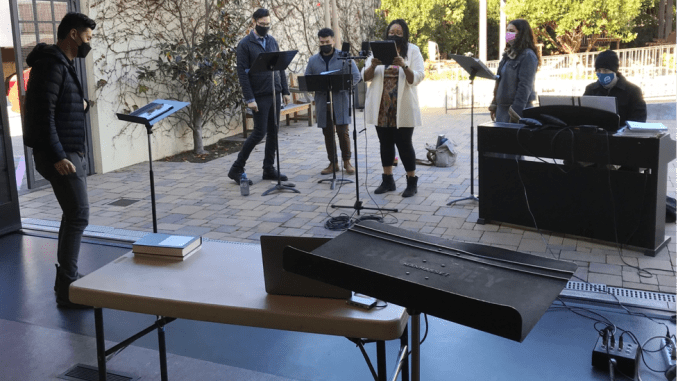
Musicians work at the Forbes Hall doorway.
It is a challenge for all participants to manage this hybrid format, where the in-person experience is blended with the remote one so that everyone benefits as much as possible from the full Sunday Worship Service.
You can join the few that attend each week by filling out THIS RESERVATION FORM and submitting your COVID-19 vaccine immunization card to the office.
For even more great photos of what happens in-person at church on Sundays, see the great photo album from Carol Ring on our news.uusm.org site.
More Ways to Give to UUSM
CONTRIBUTE TO UUSM WHEN YOU BUY GROCERIES AT RALPHS
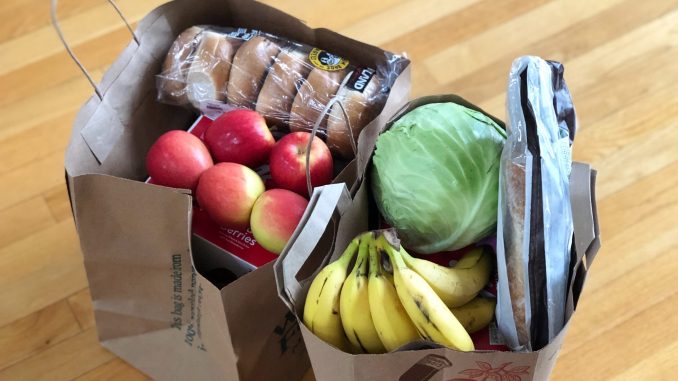
Opportunities to set up automatic giving to our church keep growing. Previously, we showed you how you can direct Amazon to automatically donate money to UUSM, based on your purchases. Now you can do the same with Ralphs (owned by Kroger).1
Ralphs is the largest subsidiary of Cincinnati-based Kroger. Their Community Contribution Program allows shoppers to contribute to non-profit organizations.
Take these two steps to set up your Ralphs account for donations to the church
You need your own personal Ralphs Reward Card to begin.
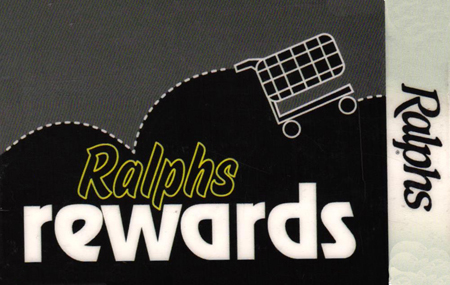
Have your card handy because you’ll need the number on the back of the card (see red arrow in picture below):
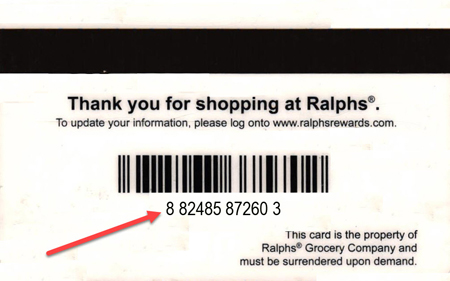
1. Create a Ralphs Digital Account
Log into the Ralphs website by going here.
On this screen, you see that you could sign in with an already existing online account (see red arrow in the screen shot below). But for the sake of these instructions, we’ll assume that you have not yet created a Ralphs online account. So click on the “Create an Account.” (See the green arrow in the screen shot below.)
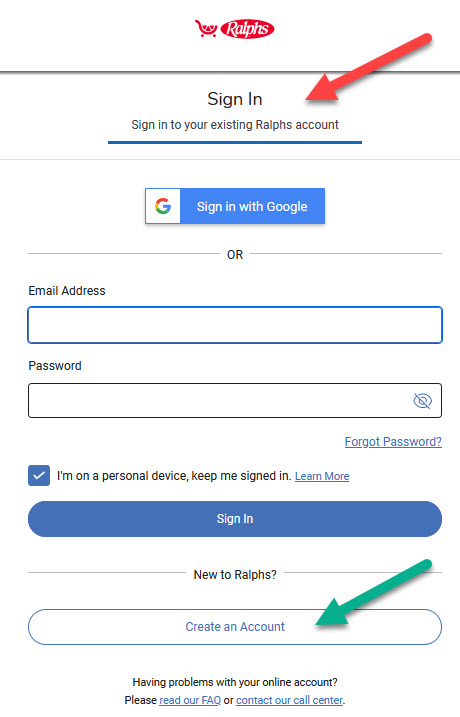
In the “Create an Account” screen, fill in the form shown below and enter your Ralphs card number (see the red arrow in the screenshot below).
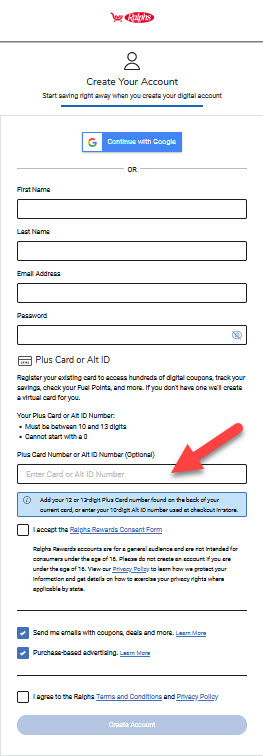
Be sure to check the two check boxes and when the form is complete, click on the blue “Create Account” button (at the bottom.)
2. Link your Card to UUSM
In the “Community Contributions” page, look toward the bottom for the “Find an Organization” field (See the red arrow in the screen show below).
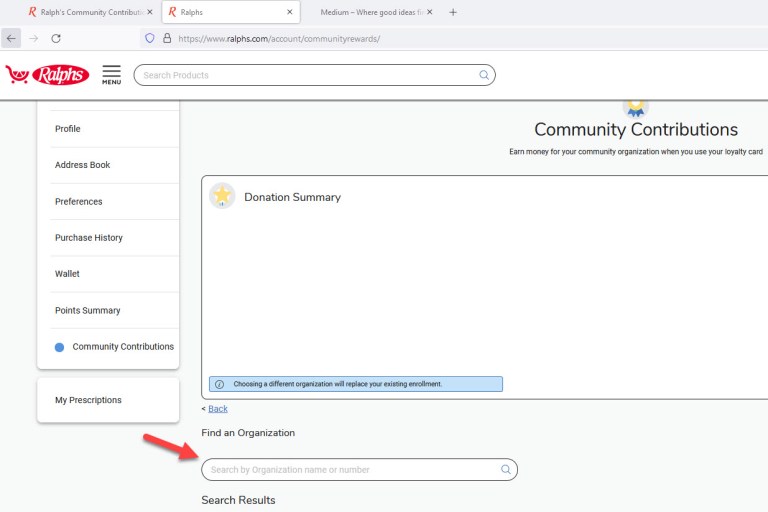
Type in the name of our church to see that it is already registered with Ralphs. In our case, type in the church name (as shown below) and click on the magnifying glass (see red arrow to the right).

When you see the organization in a rectangle, select it by clicking on the blue “Enroll” button (shown by the red arrow in the screenshot below).
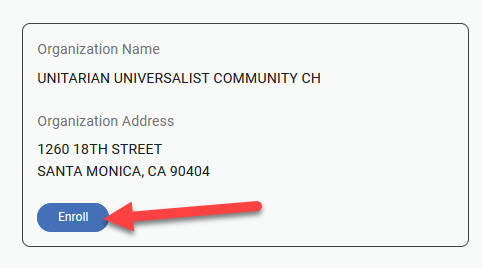
Back on the “Community Contributions” page, it shows your selection. The blue “Change Organization” button is only for changing the non-profit organization if you change your mind.
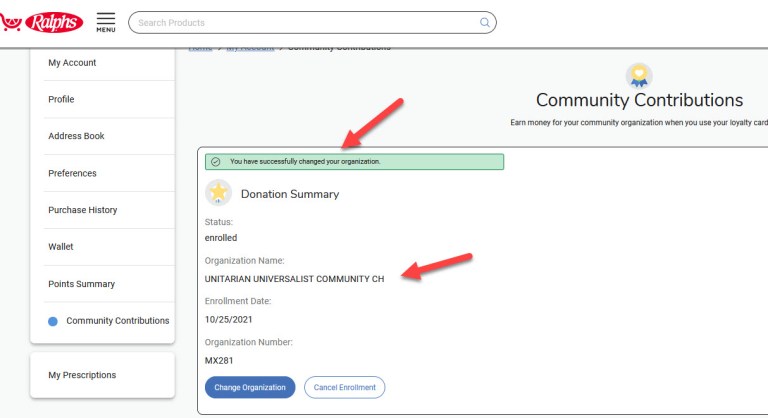
You have made your selection for charitable contributions from Ralphs.
The last thing you might want to do is update your profile for your new Ralphs account. Look to the upper left menu and click on Profile. Spend as much time as you wish to complete your profile.
At this point, you’ve set everything up for UUSM to automatically receive contributions from Ralph’s when you shop using your Ralphs card. Once it is set up, you never have to re-visit the site.

To exit their website, look to the upper right and find the person graphic (which has your name under it). When you hover over it, the menu drops down and simply click on the “Sign out” button (shown below on this screen shot.)
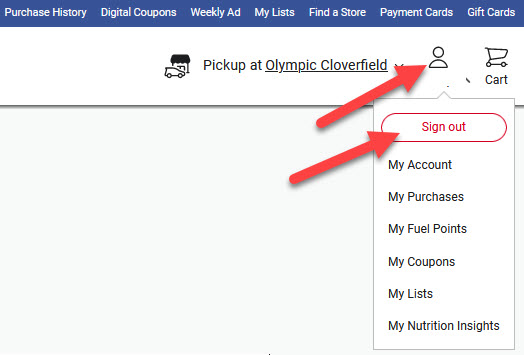
Congratulations. From now on, every purchase you make at Ralphs will accrue revenue for UUSM.
Further information on this program can be found on the Ralphs website. Should you have further questions or concerns, feel free to contact them at 1-800-576-4377 (1800-KROGERS).
1 This benefit is under Ralphs/Kroger “Community Contribution” program. It does not award the church a set percentage based on an individual’s purchases. Instead, the church receives a contribution based on two factors: 1. the total number of Ralphs cardholders who have designated the church as their favorite charity and 2. the total amount of purchases made by those using their Ralphs card who have designated the church as the beneficiary. At the end of each quarter, Ralphs divides up to $500,000 to donate to nonprofits, using the two-tier formula (above). So while it is not a fixed percentage (but rather this complicated formula), the church would receive contributions each quarter. This information is not well known to local store management but derived from their regional and national offices.
UUSM Weekend at Camp de Benneville Pines
HIKES, WORKSHOPS, GAMES, MEALS, AND MORE
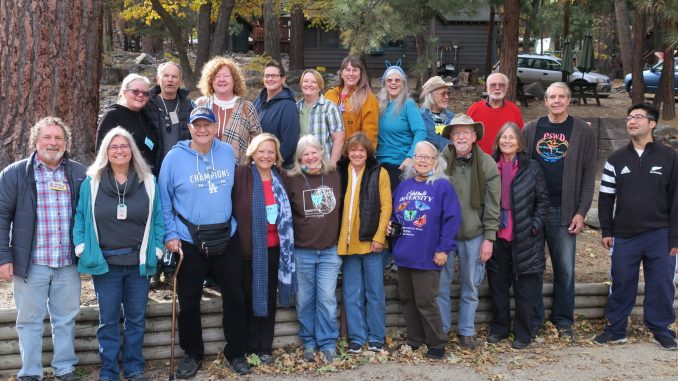
It happened. Even after we thought it might not happen, it happened. A small group of Santa Monica UU’s made it up the mountain to Camp de Benneville Pines as just the third weekend camp to use the site in more than a year.
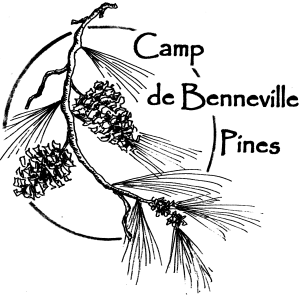 Our slice of September that became a slice of October was amazing. The weather was perfect, with crisp fall air bringing in the scent of the pines. The moon rising over the forest in the dark was so magical it was almost indescribable.
Our slice of September that became a slice of October was amazing. The weather was perfect, with crisp fall air bringing in the scent of the pines. The moon rising over the forest in the dark was so magical it was almost indescribable.
The drive up the mountain revealed many of the difficulties that have been facing the forest — not just wildfires — but also trees lost to bark beetles. Mudslides have increased the danger of rockslides. The good news is that recovery is already in process with ocotillo and chaparral covering the ground in fresh green, the healthy trees still standing, and many that have survived both recent fires.
Janet James was there to greet us, and the weekend was full of hikes, workshops, games, and meals. More than one camper expressed how wonderful it was to simply sit and share food with friends they had been missing.
There was music-making, and hours were spent singing and playing around the hearth in the lodge. A gentle hike to the lake opened up an afternoon of blue skies and autumn leaves. There was meditation and yoga on Saturday, and a powerful discussion of the Seven Principles led by Amy Brunell on Sunday morning.
The Santa Monica campers were joined by some work weekend volunteers, who shared our meals and took care of some of the tasks of camp — tree limbs trimmed, leaves raked, and walls painted.
The camp that we love will take all the support we can offer to keep things going through this difficult time.
Thanksgiving Camp is already sold out, and folks will get to continue the decades old-tradition.
Camp will be closed December through March by direction of the Board, but there will be space for volunteers and work parties.
De Benneville Pines is a unique treasure. If you are a member of the congregation who goes often, you already know. If you have not yet been, put it on your calendar for next year. If you can contribute — with funding or skills, time, and sweat equity — this is the time for you to offer.
Not every church gets a bit of wilderness to cherish and to steward. Keeping our camp takes effort, and the benefits are almost indescribable.
For some more great photos of our weekend, see https://news.uusm.org/uusm-weekend-at-debenneville-pines/
New UUSM Website Coming to a Screen Near You
Imagine a world where uusm.org is fresh, streamlined, and oh-so-au-courant. Strangers come and instantly view Sunday worship; discover what UU Santa Monica is all about; and explore activities we’ve got coming up. Members find the latest news and their preferred donation method quickly, and they can easily log in behind-the-scenes to see private contact info, board minutes, and financial statements.
Well, the hardworking website team – along with staff, a consultant, and some temp volunteers – are approaching the debut of a new uusm.org. The goal of the public-facing portions of the new site is to expand our membership: to efficiently guide brand-new visitors to the conclusion that UUSM church life could be for them (or not) and draw in more visitors to worship, special events, and small-group activities. The members-only areas will feature easy sign-in (all Members and Pledging Friends are being issued login credentials) and quicklinks to take members to what they most commonly need. Members will also be able to access important documents like Annual Meeting materials, bylaws, and historical Newsletters, News Magazines, and announcements; though it may take a while to load it all in.
Besides looking more up to date, the security of our digital home will be much improved; we’ll be less vulnerable to hackers and scammers. The new site is based on the WordPress platform, so it can be easily updated as needs and circumstances change. It’ll look better on our phones, which is how more and more visitors experience our website, and there are lots of “plug-ins” available that improve the site experience. Future refreshes to keep up with internet design trends will be SO much easier.
The separate news site you’re reading here will fuse right in to uusm.org, and the display of public events will be enhanced to increase interest and attendance. A separate calendar, behind the member login, handles nonpublic committee meetings and room rentals.
The UU Santa Monica website will look and feel different, for sure; and it’ll continue to evolve in the weeks, months, and years to come. Look for coming announcements about the big reveal, your members-only login, and how to stay informed via email.
Celebrating the Life of Anne Hastings MacQueen
IN PERSON IN THE UUSM COURYARD
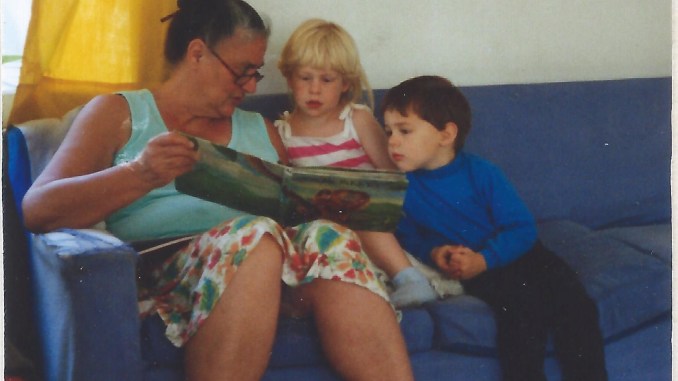
A Brief Biography
Anne Hastings MacQueen was born December 24, 1933, in Lewes, Delaware and died January 30, 2021, in Santa Monica, California. She spent her early years in Seaford, Delaware partly in a house her grandfather built, adjoining their farmland, and partly in the town where her father ran a local newspaper. Perhaps some of her progressive ideas were formed at that time, in the small, segregated community her father took the then radical step of hiring a black person to assist at the newspaper. She had many stories of those early years, especially of her two adored older brothers, Woodland and Stevens.
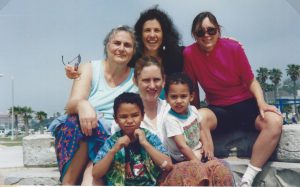 At the age of 14, immediately after WWII, she attended high school at an international school in France and also helped with the war recovery efforts in Germany. She returned to the U.S. for her final year at Putney in Vermont, before attending Reed College in Oregon where she met her husband, Jim MacQueen and started a family. Son Donald was born in 1953 in Oregon, daughter Katherine in Berkeley, California and daughter Mary in Santa Barbara, California where Jim pursued graduate studies and then work.
At the age of 14, immediately after WWII, she attended high school at an international school in France and also helped with the war recovery efforts in Germany. She returned to the U.S. for her final year at Putney in Vermont, before attending Reed College in Oregon where she met her husband, Jim MacQueen and started a family. Son Donald was born in 1953 in Oregon, daughter Katherine in Berkeley, California and daughter Mary in Santa Barbara, California where Jim pursued graduate studies and then work.
The family finally settled in Santa Monica. Eventually, Anne achieved a bachelor’s degree in anthropology from UCLA, and worked as an analyst. It was after her retirement that her grandchildren began arriving – they were one of her great joys in life, and she spent many hours helping and playing with them.
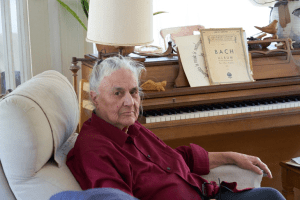 Anne joined the UU of Santa Monica in the 1970s and, following retirement from her career as an analyst, worked for the church doing accounting and helped in the office with the newsletter. She enjoyed inviting church members to dinner and beach walks for its “Dining for Dollars” campaigns, and the many festivals, programs and events put on by the church.
Anne joined the UU of Santa Monica in the 1970s and, following retirement from her career as an analyst, worked for the church doing accounting and helped in the office with the newsletter. She enjoyed inviting church members to dinner and beach walks for its “Dining for Dollars” campaigns, and the many festivals, programs and events put on by the church.
She is survived by one son, Donald, two daughters, Katherine and Mary, five grandchildren, Metabrafor, Sarah, Onome, James, and Kiemute, and one great-grandchild, Eleanor.
The family invites you to a celebration of Anne’s life on Saturday, November 6 in the courtyard at church, at 11:00 am.
- The church’s rules for the gathering include being vaccinated, wearing a mask, practicing social distancing, and not eating or drinking onsite.
- Please RSVP to: Kate.
- A parking attendant will be available to greet us at the Santa Monica UCLA hospital structure south of Arizona, at the entrance on the east side of 16th Street. If you park on the street instead, please read the parking signs before you turn off the key, to avoid a ticket.
- If the weather is cool, please dress warmly as we will be outside — as we gather to remember someone who loved being outside!
September Update on the Arizona Lobby Repair Project
CONSTRUCTION ESTIMATES ARE IN
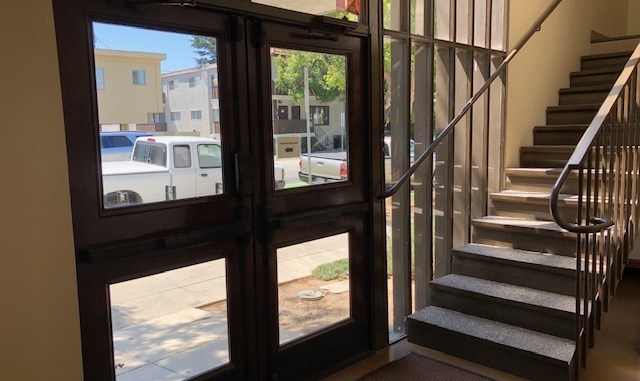
The Arizona lobby of Forbes Hall on our campus is sinking. The floor is cracked and the doors are not operable. After years of temporary solutions it is time to solve the problem, and at the same time install glass doors into the Garden of Eternity so that it becomes the attractive, peaceful place for quiet contemplation that was envisioned when it was created. The congregation authorized the expenditure of reserve funds to complete this project.
We hoped to be able to replace the decaying windows and the stairs to the second floor as part of the same project. As construction cost estimates have come in, we realized we won’t be able to replace the stairs at this time.
Our current project scope includes:
- A new foundation under the Arizona lobby
- New flooring in the lobby
- Replacement of the Arizona doors
- Replacement of the Arizona windows with new energy-efficient double-glazed windows in frames that require much less upkeep
- Installation of a new glass doorway into the Garden of Eternity
- A temporary door on Arizona will be installed in September so that an exit can be operable when we begin to use the church campus again.
Your construction management team is led by Church Administrator Nurit Gordon, supported by Bryan Oakes from the Facilities Management Committee and Abby Arnold from the Board of Directors. We will submit an application for a construction permit to the City of Santa Monica in the next few weeks, and expect approval to begin construction in December or January.
Special District Meeting August 21 on Dissolving PSWD
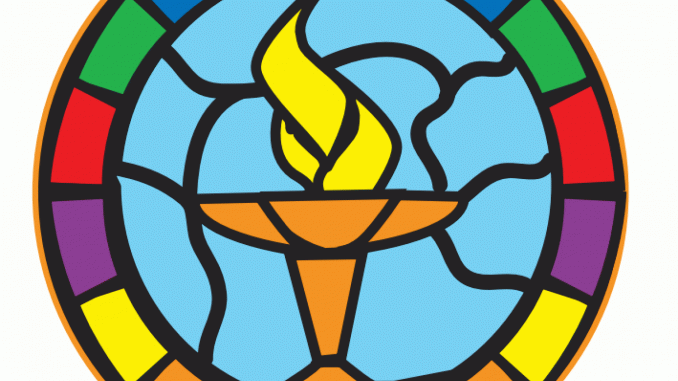
The Pacific Western Region (PWR) of the Unitarian Universalist Association (UUA) includes all the states from Montana to Washington and Alaska in the north through New Mexico to California to Hawaii in the south. PWR is composed of the UU congregations in four districts, including our own Pacific Southwest District (PSWD). Regionalization is the process of restructuring all UUA districts into five Regions; this new structure is meant to better utilize the resources of staff and volunteers.
At a virtual PWR meeting in February 2021, PSWD Board President Rev. Kevin Lawson provided an update on the status of our district. He shared that there were no nominees to fill any of the upcoming vacancies on either the District Nominating Committee or the Board of Trustees. Given this information, the members of the PSWD Board discussed dissolving the District Board; they recommended that PSWD be absorbed into PWR. Three of the five District Board members who would have transitioned off at the end of their terms this June agreed to stay on through October 2 to facilitate the dissolution of the District. (Note: Camp de Benneville Pines is an independent Covenanting Community and will not be affected by this transition.)
 A series of open meetings held from March to July explored the issues involved, while a team of experts within the four districts of PWR drafted a resolution to formally close the entity that is PSWD. Given the current circumstances, the PSWD Board believes the vote of congregational delegates that is scheduled for August 21 is the best course of action, and the Board is committed to proceeding in a timely way. The August vote would lead to a dissolution of PSWD in October, when the 50 congregations (13 in Arizona, 36 in California, one in Nevada) will continue to be served by the Region — instead of by both PSWD and the Region.
A series of open meetings held from March to July explored the issues involved, while a team of experts within the four districts of PWR drafted a resolution to formally close the entity that is PSWD. Given the current circumstances, the PSWD Board believes the vote of congregational delegates that is scheduled for August 21 is the best course of action, and the Board is committed to proceeding in a timely way. The August vote would lead to a dissolution of PSWD in October, when the 50 congregations (13 in Arizona, 36 in California, one in Nevada) will continue to be served by the Region — instead of by both PSWD and the Region.
Beth Brownlie, our church President, asked me to look into this matter and tell you about it. Because I loved being involved in PSWD leadership activities in the past, I was interested in reviewing the current proposal to give you a summary — but my research came after the series of meetings had been held. From what I’ve read, I regretfully support the proposed dissolution. In future we can explore making better use of the many UU resources that are available as well as improve connections between our congregation and neighboring ones, the Region, and the UUA. I encourage everyone to participate in that process by joining in the GLAM SUUmmer Road Trip services; they’re wonderful!
To clarify, I favor dissolution because it was evident to me awhile back that the UUA had withdrawn from supporting the many districts in favor of just several regions. The UUA did this restructuring despite the reality that the western districts and region have thousands of miles more territory than any others in the denomination. Then in February no candidates were found to serve on PSWD’s Board or Nominating Committee; so, it’s time to move forward by dissolving the entity that is our District. Details on the series of meetings held in the past six months, plus the actual wording of the proposed resolution, are available by clicking on the links below. Beth adds, “Bottom line: it does not look like it affects us too much, it looks like UUA is just trying to use resources more wisely.”
Denominational affairs are important, especially because we’re a congregation involved in the exciting process of Developmental Ministry. We can’t grow into being our best local community without meaningful involvement in the wider UU community! Please consider volunteering to serve as a delegate to the August 21 meeting by emailing our Church Administrator, Nurit Gordon by August 17. If you have ideas or input for our delegates, please include them in your message.
February announcement of Series of meetings toward Transition in October
Sigh… it looks like change is coming to us in yet another form this year, but we can make the best it.
Thoughtfully yours,
Joyce Holmen
Joyce Holmen
Update on Arizona Lobby Architectural and Engineering Plans
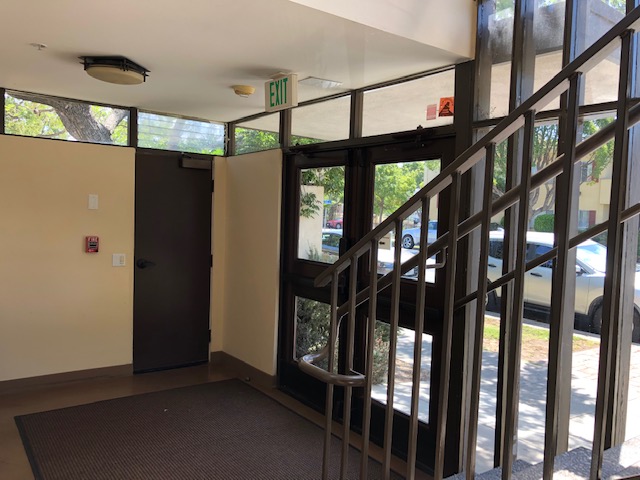
The Arizona Avenue lobby of Forbes Hall will be repaired and renovated over the next few months to fix the underlying conditions that make the Arizona doors inoperable and to add a visually inspiring entry into the Garden of Eternity. Funding for the project was approved by the congregation at our annual meeting on June 27, 2021.
Our architect, Ralph Mechur, continues to finalize the plans with information obtained from our engineering consultant. Mr. Mechur will submit the plans to the City of Santa Monica and we hope the City approval process will only take several weeks. As it stands now, work will be completed at the beginning of 2022. A temporary door will be installed at the Arizona entrance for the duration of the project.
Church Administrator Nurit Gordon serves as the church’s project manager and meets with Mr. Mechur at least every other week, along with Bryan Oakes from the Facilities Committee and Abby Arnold from the Board of Directors. The committee will keep the congregation informed of the progress of the project as it moves forward.
Dining for Dollars Concert by Kai Landauer and Lesley Kernochan
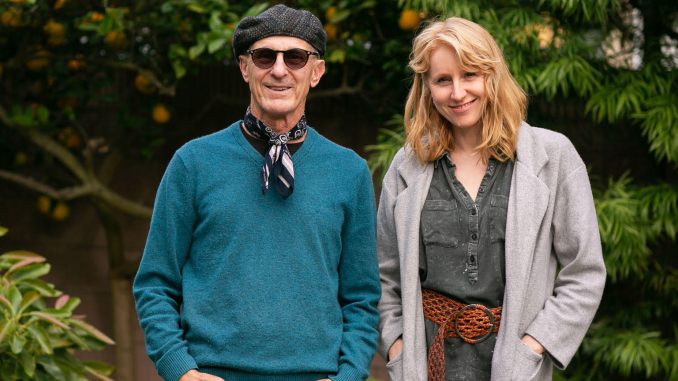
In an intimate and friendly garden event at Janet Goodwin’s and Karl Lisovsky’s house in Venice, Kai Landauer (aka Karl Lisovsky) and Lesley Kernochan hosted a short concert of Kai’s original songs, accompanied by guitarist Barrett Tagliarino and percussionist Diana Perkins. This was also a Facebook Live Event, where people from as far away as Chicago and Seattle tuned in, as well as UUSM members. This summer’s event was one of many items in our Spring 2021 Dining for Dollars auction, which together raised over $7,000 to support the work of our church community. Thank you to all who bid in our auction!
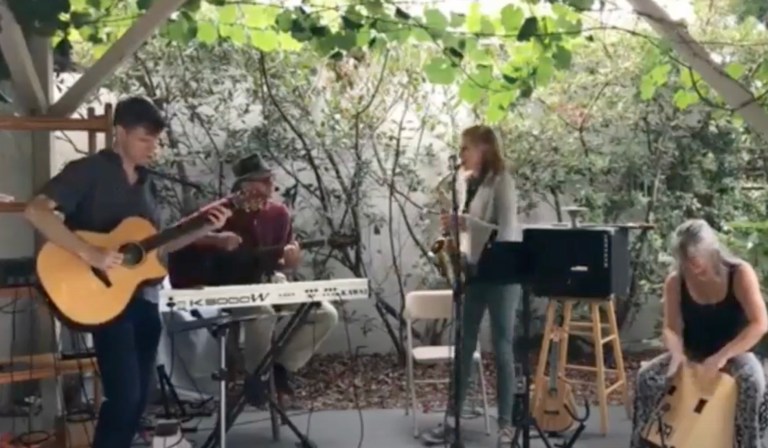
The concert also celebrated Kai and Lesley’s CD “I Believe in You,” which is available to anyone who would like it. Just email kflsongs@icloud.com with your mailing address and you will receive the CD promptly.
Amazingly, you can enjoy this concert right now.
The title song on the album also has its own inspiring video.
Kai Landauer notes: I started writing songs seriously as a teenager, modeling my work mostly on the Beatles, but influenced by Harry Belafonte, Simon and Garfunkel and Dylan. Some of my songs originated a long time ago, like in the 1970s, but have lain dormant in one state or another for years. 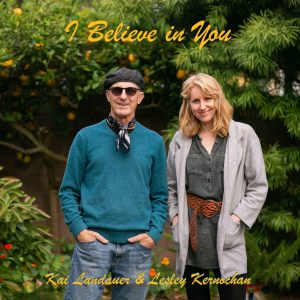 This is particularly true of melodies, which were born years ago but found their lyrics much later. For example, Rainy Day Lover as a tune and as a title originated in 1974, but I finally figured out that it was to be a “spiritual autobiography” in the 1990s. Recently, I have come to rely more and more on professional talent like Lesley, as well as people like Barrett and Diana, the guitarist and percussionist in our concert, to produce a quality that I as a musician simply can’t match. I owe the commercial-grade quality in my most recent songs to the guitar, piano, violin, percussion that these musicians offer. Kai’s website.
This is particularly true of melodies, which were born years ago but found their lyrics much later. For example, Rainy Day Lover as a tune and as a title originated in 1974, but I finally figured out that it was to be a “spiritual autobiography” in the 1990s. Recently, I have come to rely more and more on professional talent like Lesley, as well as people like Barrett and Diana, the guitarist and percussionist in our concert, to produce a quality that I as a musician simply can’t match. I owe the commercial-grade quality in my most recent songs to the guitar, piano, violin, percussion that these musicians offer. Kai’s website.
 This is particularly true of melodies, which were born years ago but found their lyrics much later. For example, Rainy Day Lover as a tune and as a title originated in 1974, but I finally figured out that it was to be a “spiritual autobiography” in the 1990s. Recently, I have come to rely more and more on professional talent like Lesley, as well as people like Barrett and Diana, the guitarist and percussionist in our concert, to produce a quality that I as a musician simply can’t match. I owe the commercial-grade quality in my most recent songs to the guitar, piano, violin, percussion that these musicians offer. Kai’s website.
This is particularly true of melodies, which were born years ago but found their lyrics much later. For example, Rainy Day Lover as a tune and as a title originated in 1974, but I finally figured out that it was to be a “spiritual autobiography” in the 1990s. Recently, I have come to rely more and more on professional talent like Lesley, as well as people like Barrett and Diana, the guitarist and percussionist in our concert, to produce a quality that I as a musician simply can’t match. I owe the commercial-grade quality in my most recent songs to the guitar, piano, violin, percussion that these musicians offer. Kai’s website.
Lesley Kernochan is an Americana folk singer/songwriter with prayerful lyrics and occasional bursts of jazzy mouth trumpet. Within each song Lesley’s versatile voice brings music to life that is “uniquely beautiful…[with] lively and sharp intelligence.” [No Depression] Lesley has an eclectic background as a saxophonist, contemporary classical composer, operatically trained coloratura, and musical saw player. Currently she primarily performs on guitar, ukulele, and piano. She has five albums of original music including the a cappella creation Undulating, her indie folk/rock sensation The Pickle Jar, the surprise twist children’s book and album A Day in the Life of a Boogaleeboo, Americana country/folk record A Calm Sun, and the eclectic Americana album The Hummingbird Revolution. Lesley’s website.
And keep an eye out for the next fun UUSM auction!

Technology Transitions Begin for Live + Streaming Worship
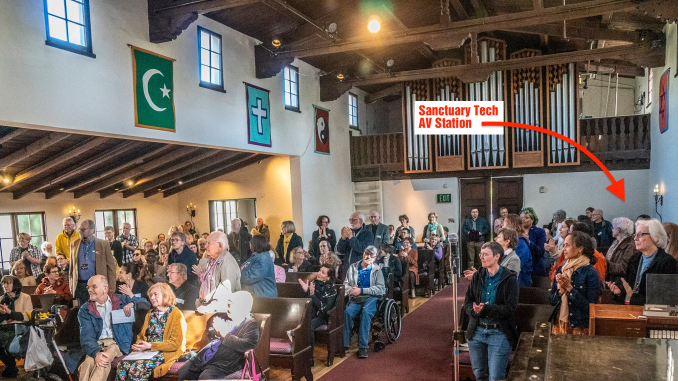
While many things still remain unclear in the world, the UUSM Transition Task Force (Saunder Choi, Aubrey Sassoon, Brad Hutchinson, Beth Brownlie, Elizabeth Fuller, Nurit Gordon, and Rev. Jeremiah Kalendae) has been planning for new ways for UUSM to share our community and our programs while accommodating the diverse needs of our congregation. Even before the pandemic, there was a growing recognition that upgrading our technology to allow for the streaming of live in-person programs was needed to facilitate community connection. So before we go back to regular in-person services, the Task Force has been preparing what they think will be a fantastic suite of technology to allow UUSM to stream across multiple platforms in ways that feel engaging and truer to the in-person experience.
With the help of a $10,000 Spirit Level Foundation matching grant written by Rev. Jeremiah and Music Director Saunder Choi, the transition team is working to upgrade the sanctuary’s audio system, purchase new computer-controlled cameras, and formulate a new part-time professional staff role to operate the system. Once hired, this new employee will also collaborate with our worship team to deliver an enhanced experience both inside the sanctuary and for at-home viewers.
This means that the presentation of the service won’t be exactly the same as it was before the necessary move to online-only programs during the pandemic, but we all are different now as well. The transition team hopes to provide the groundwork for a more enriching and rewarding experience for our community and those who enjoy our programs and facilities for many years to come.
To provide a slightly clearer picture of what to expect when we return to live services, tentatively scheduled for September 5, Aubrey Sassoon from the Transition Task Force reports that a tech booth to manage the programs “will likely be set up in the back corner of the sanctuary by the main doors where the current audio connections are, but all plans are tentative while the system is being set up. It will also likely evolve over time from a simple computer desk into possibly something more permanent after we come back, and the community is able to give input.”
The projector and drop-down video projection screen will still be used although some adjustments may be made. According to Aubrey, the Transition Team is “also planning to update the TV setup along the library wall in Forbes Hall to receive the livestream with hopefully little to no delay so that those watching from Forbes can have a greatly improved viewing experience.”
Saunder says that all the audio and video equipment has finally arrived, so “now we just need to install them.” This includes new mics, a sound board, cameras, computers, and switchers for streaming.
In the end, what may be the most important component in returning to live in-person services is that everyone in attendance is fully vaccinated. Please, if you can, do your part to keep us all and yourself safe. The health and safety component of our return to live services is still being developed. More information will be provided later in the month.

